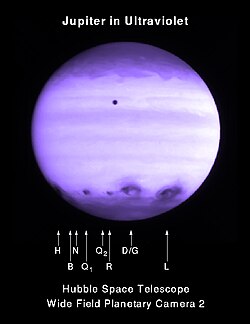Portal:Jupiter/Radiation astronomy/3
Ultraviolet astronomy
[edit | edit source]

In astronomy, very hot objects preferentially emit UV radiation (see Wien's law). Because the ozone layer blocks many UV frequencies from reaching telescopes on the surface of the Earth, most UV observations are made from space.
At right is an ultraviolet image of aurora at Jupiter's north pole by the Hubble Space Telescope.
"Experiments on the Voyager 1 and 2 spacecraft and observations made by the International Ultraviolet Explorer (IUE) have provided evidence for the existence of energetic particle precipitation into the upper atmosphere of Jupiter from the magnetosphere."[1]
The image at lower right shows Jupiter's atmosphere at a wavelength of 2550 Angstroms after many impacts by fragments of comet Shoemaker-Levy 9. The most recent impactor is fragment R which is below the center of Jupiter (third dark spot from the right). This photo was taken 3:55 EDT on July 21, about 2.5 hours after R's impact. A large dark patch from the impact of fragment H is visible rising on the morning (left) side. Proceding to the right, other dark spots were caused by impacts of fragments Q1, R, D and G (now one large spot), and L, with L covering the largest area of any seen thus far. Small dark spots from B, N, and Q2 are visible with careful inspection of the image. The spots are very dark in the ultraviolet because a large quantity of dust is being deposited high in Jupiter's stratosphere, and the dust absorbs sunlight.
References
[edit | edit source]- ↑ T. E. Cravens (1987). "Vibrationally excited molecular hydrogen in the upper atmosphere of Jupiter". Journal of Geophysical Research 92 (A10): 11,083-100. doi:10.1029/JA092iA10p11083. http://www.agu.org/pubs/crossref/1987/JA092iA10p11083.shtml. Retrieved 2012-07-09.
